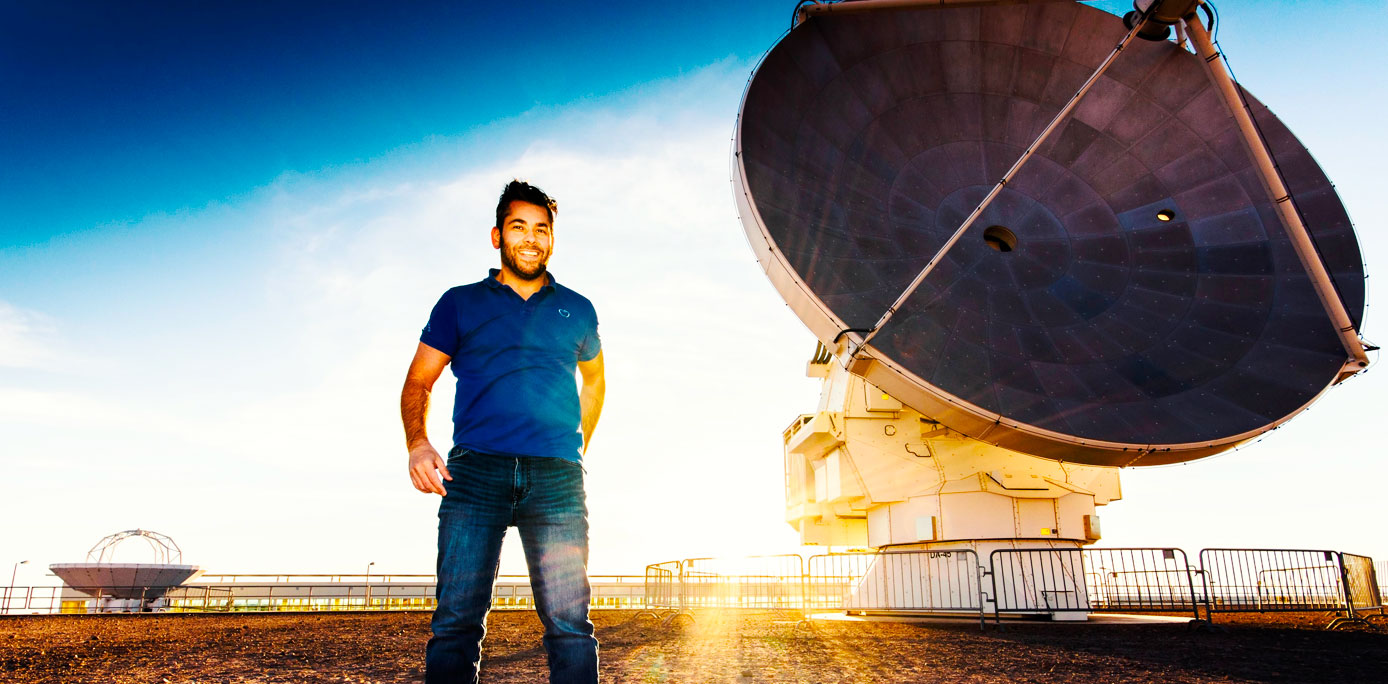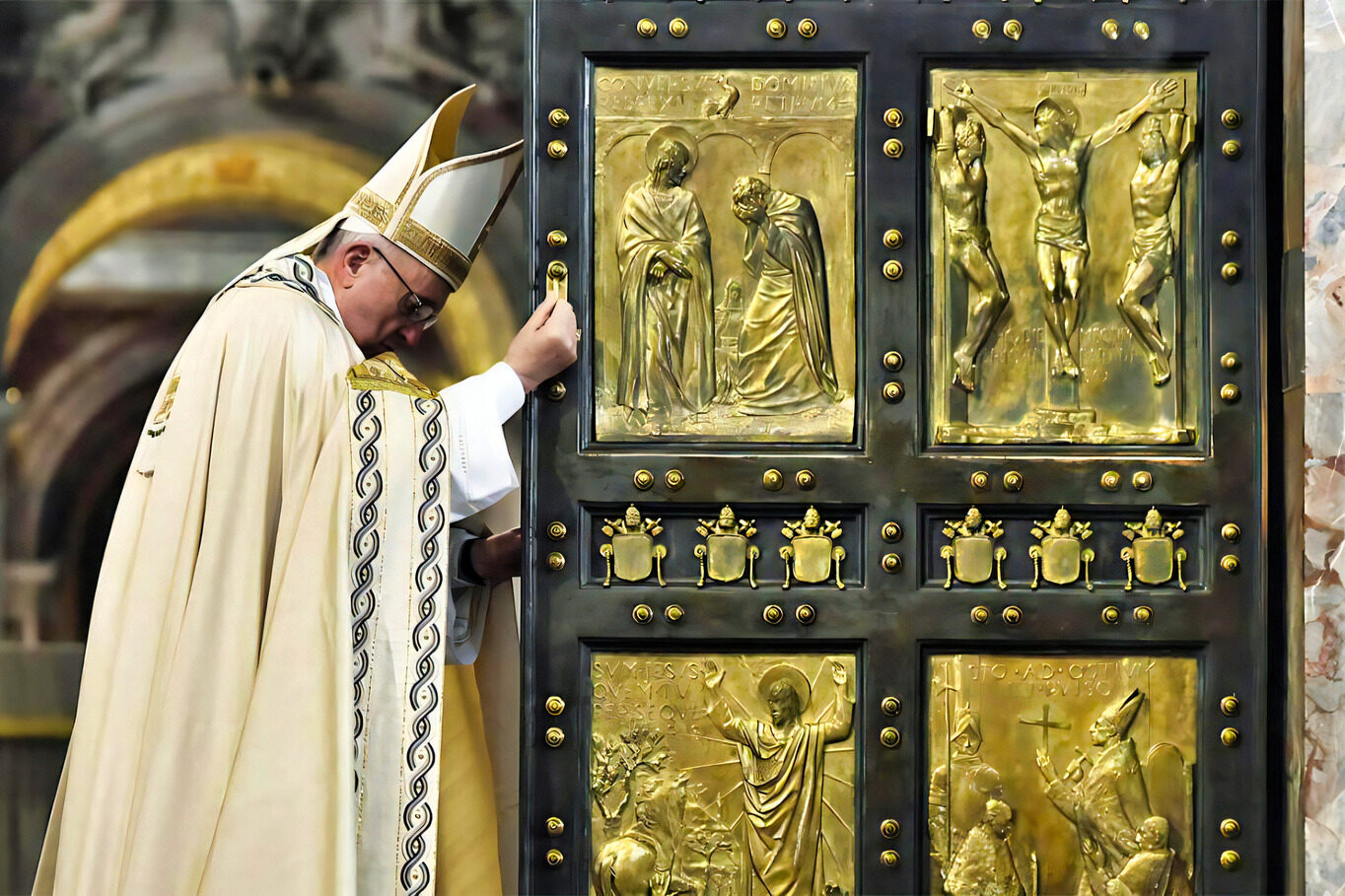It is considered the photo of the century. He has not (yet) won the Pulitzer but has shown Einstein’s General Relativity. With two super-computers, one at Boston’s MIT, and a network of radio telescopes from 12 to 30 meters in diameter on the various continents, it immortalized a piece of science fiction: the horizon of events, the distortion of space-time, the shadow of a black hole.
A Nobel Prize project.
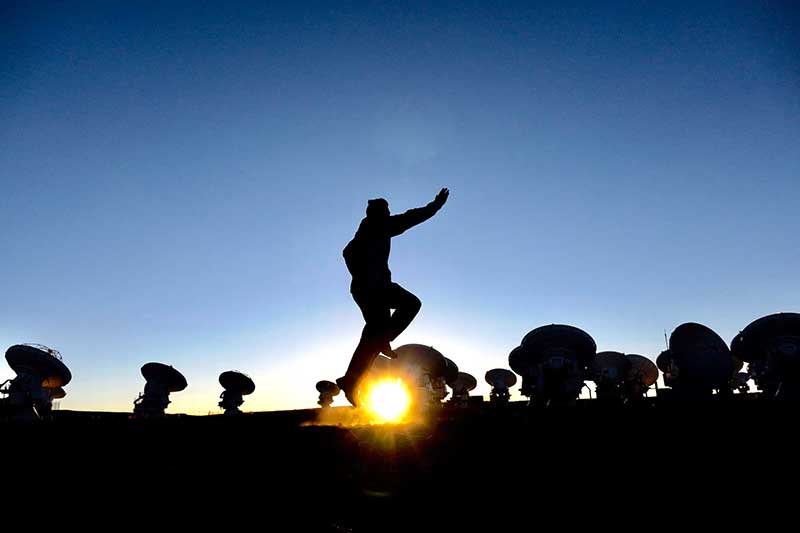
L’Italo-Americano interviewed the Sardinian astrophysicist in charge of the BlackHoleCam project. Ciriaco Goddi, 43, degree and PhD in Physics at the University of Cagliari, three years at Harvard, Germany, and in Holland since 2012. All the way to EHT: Event Horizon Telescope, the international project that measures the enormous mass of the black hole at the center of a galaxy 55 million light years away from Earth. Italy participates with several scientists, the National Institute of Astrophysics (Inaf) and the National Institute of Nuclear Physics (Infn).
What types of emotions, personal and scientific, do you feel when looking at this part of the universe?
During the past weeks, I have understood that a photo of a black hole can give emotions to everyone, even those who are not experts in science or astrophysics.
As researchers, we spent decades waiting for this, so ours is a different, more personal type of joy, as we see our dream come true. But even I, who have worked for years on this project, feel a unique emotion when I look at that image, knowing it is a ring of matter and light shaped by space-time deformation, a consequence of the very strong gravity associated with the massive object at its center: a black hole. Not a simulation or an animation — we have seen thousand of those — but the very shadow of a black hole, a place from which not even light can escape, just as Einstein had predicted.
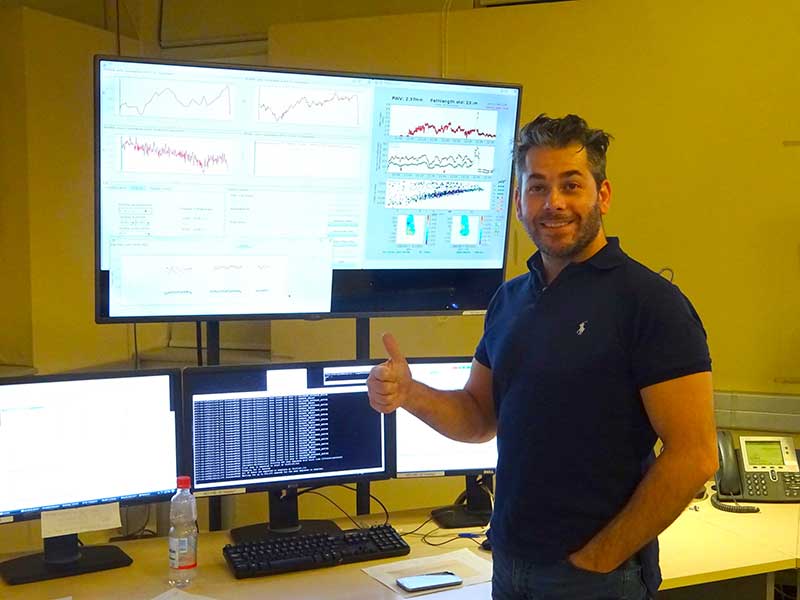
Ciriaco Goddi in his office © Ciriaco Goddi
What can you see beyond that black circle wrapped in incandescent light?
Looking at the image, one can imagine what happens to the plasma orbiting around the black hole, rotating at speeds close to that of light, accelerating and gradually descending the spiral staircase that leads it beyond the event horizon, where it disappears for ever, swallowed by the black hole itself.
It’s almost like one can feel (and not just see) the luminous eddy of matter that coils around until it disappears into the deep black of that hole.
Someone defined the event horizon the “gates of eternity.” It is a beautiful thought, it gives the chills. And the awareness that, from now on, the event horizon is no longer just an immaterial mathematical concept — the mathematical solution of a theory — but has become a physical object, observable and measurable by scientific method, is a huge achievement for us astrophysicists, and an exciting idea in general.
Even if we don’t know what happens in there, the mere fact of being able to see it with our own eyes makes science fiction dreams less surreal.
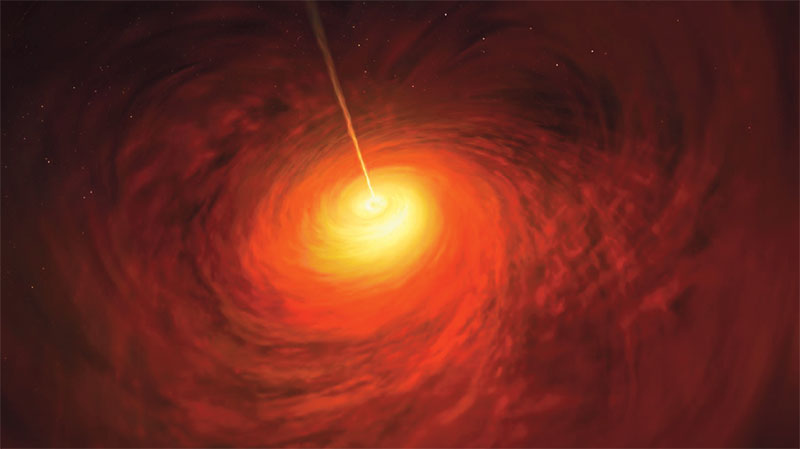
The black hole at the center of M37 @INAF
Your contribution is a “great step of humanity.” What does it feel like to have helped create a new page in the history of astrophysics?
When we started, we were aware of the difficulties. We were pushing the limits of current technology, but at the same time we were sure we would succeed. It was a long journey, an emotional one, at times.
This result comes more than 100 years after the publication of Einstein’s Theory of General Relativity and Schwarzschild’s mathematical solution that predicts the singularity and existence of black holes (at least mathematically). After the pioneering studies of the 1970s, which used the first simulations to predict black holes’ appearance (if they could have been observed), in 2000 we had the intuition that observing the super-massive black hole at the center of the Milky Way could have been possible thanks to the technology available.
Thoughts went in particular to the very-long baseline interferometry technique (VLBI) used by EHT, which was followed by a successful technological development (started about 20 years ago) aimed at applying this technique to high radio frequencies (used by EHT). Projects began being developed in the United States and Europe around 4-5 years ago, and they were dedicated exclusively to this goal. They developed first independently and then jointly, with the first global observation campaign taking place in 2017. There was a scrupulous work on the elaboration of the data collected in the last 2 years, which finally allowed us to see what seemed invisible: the black hole. Now we know what it looks like. It took a long time, but we’ve finally succeeded. It’s incredible.
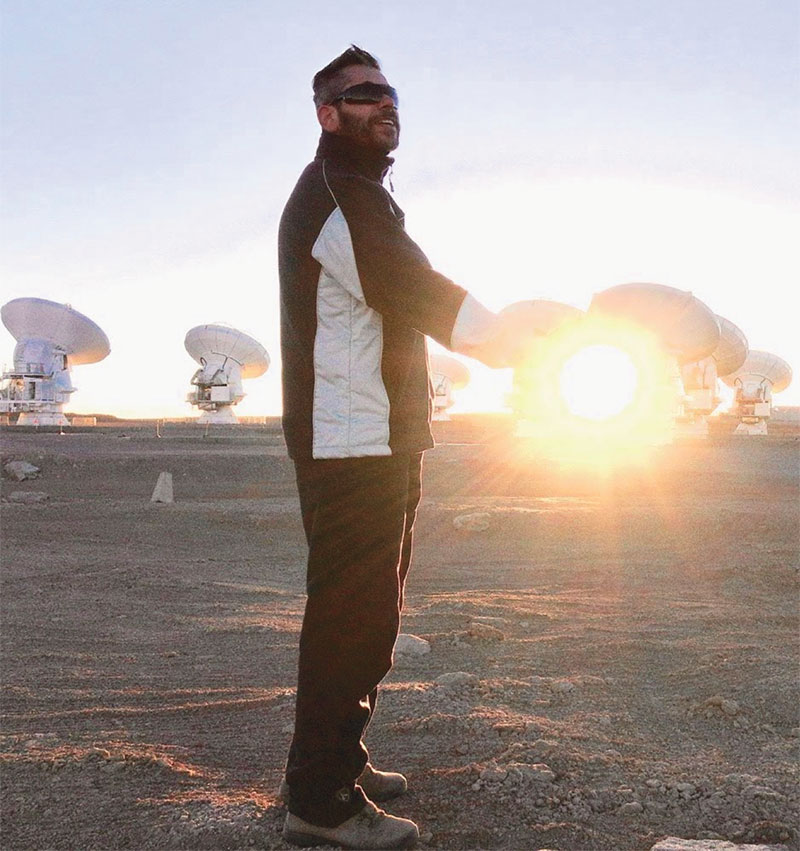
Italy participates with several scientists, the National Institute of Astrophysics (Inaf) and the National Institute of Nuclear Physics (Infn). © Ciriaco Goddi
An enormous effort.
I can say that the image of the black hole at the center of the M87 Galaxy is, simultaneously, a great success of scientific research and an exciting representation of something we could only imagine until now. The success of research lies in a new proof of Einstein’s Theory of Relativity, but above all it is a further confirmation of the impact international collaboration and large infrastructures can have on the future of human knowledge.
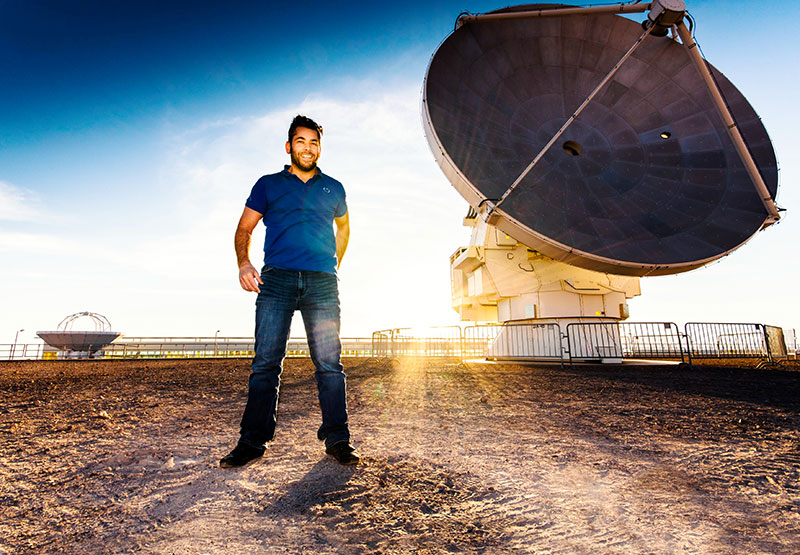
Event Horizon Telescope, the international project that measures the enormous mass of the black hole at the center of a galaxy 55 million light years away from Earth © Ciriaco Goddi
What was the role of Italian scientists in this project?
Luciano Rezzolla (University of Frankfurt), one of the 3 PIs of BHC, and I, have been involved since 2014. Another researcher, Mariafelicia de Laurentis, full professor at the University of Naples and affiliated with Infn, joined the Frankfurt group as an expert on gravitation theories in 2016. In 2018, we introduced to BlackHoleCam two researchers from the Italian ALMA Regional Center node (INAF – IRA in Bologna), Elisabetta Liuzzo and Kazi Rygl, who became members of the EHT Consortium through their affiliation with BHC.
Then we should also include Violette Impellizzeri, who works in Chile for Atacama Large Millimeter Array (ALMA), the largest terrestrial radio telescope, who contributed decisively to the collection of data necessary to obtain the image of the supermassive black hole at the center of M87. As an astronomer and as responsible for the calibration of ALMA as a VLBI station, I carried out all the observing campaigns in the Atacama desert in Chile. With Violette, we spent many nights watching M87 with ALMA. Although not a full member, Violette is a co-signer of the article published in the Astrophysical Journal, which reported the image.
From now on we can talk about a new era of research. What does this exactly mean?
The certainty of being part of an epochal change, a passage between “before” and “after” is extremely exciting. We can really say that, from today, physics are no longer the same. What until yesterday was only an immaterial mathematical concept, a mathematical solution to a theory, has now become a physical object, observable and measurable by scientific method. A sort of laboratory where we can carry out experiments about gravity, to which we didn’t have access before. This is what black holes are now.
Our hope was, if we had ever succeeded in creating the first image of a black hole, that this photo could end up in textbooks. I hope this will really happen. History books will be divided between the times before and after this image was taken.
The photo proved human theories — human imagination — right…
This experiment —its result — could be the beginning of a new era. For the first time we see the event horizon and we can study general relativity on a scale and regime unimaginable before. And the most surprising aspect is that everything we see is perfectly in agreement with the prediction provided by the Theory of Relativity. Einstein also passed this test with tremendous success! Incredible and excellent, Einstein, who initially did not believe in the concept of black holes and had to struggle a bit with the idea of the event horizon. Today, after a hundred years, we showed it is a reality of the universe. This would have been absolutely incredible to him. Another great scholar of black holes, Stephen Hawking, died too early to see this result, but he would have had the same emotional reaction we had in finally seeing the ultimate limit of space and time. This is really the golden decade to study black holes.
What’s inside a black hole?
We don’t know, since we can’t access it.
Perhaps there is matter that cannot be compacted, or perhaps matter has already been entirely concentrated into one sole entity, just as it happened for the Big Bang (exciting no?),and has been “converted” into a curvature of space-time … who knows!
Speculating is free, since nobody can come back and tell us what’s in it !
What about Einstein: was his theory correct or did your observations brought some corrections to it?
The short answer is: yes, Einstein was right, at least for now.
Overall, the observed image is consistent with the expectations for the shadow of a rotating black hole with a spin different from zero —also known as Kerr black hole — as foreseen by the Theory of Relativity. However, I can say that the observations made are not consistent with many of the alternatives to Kerr black holes proposed by previous models.
It’s still science fiction today, but could it be possible to open, sooner or later, a door in time? And is the fantasy-scientific idea of using black holes as “hyperspace slings” in any way theoretically possible?
For the moment, space travel is only possible within the Solar System. But it is also true that some mathematical solutions to Einstein’s equations (and to other theories of gravity) seem to suggest the possibility of traveling between any two points in space and time. This is a direct consequence of the space-time curve around an intense gravitational field, as predicted by Einstein’s relativity.
The most representative case is that of the so-called Wormhole, which could be described as a tunnel, a “shortcut” in space-time. In addition to the three spatial dimensions, Einstein’s equations include time as the fourth dimension: it follows that the presence of a black hole also curves time, and thus allows time travel. These, however, are hypothetical considerations. I mean, here we go into science fiction. In fact, the Wormhole is the preferred way for a writer or a science fiction director to explain space travel. Think of the 2014 Hollywood movie Interstellar, with Matthew McConaughey playing a NASA astronaut who has the task of exploring 3 planets in another galaxy with the hope that one can host humanity. And how does it get there? Through a Wormhole that allows you to cut through the 26.000 years you’d need to get there … in short, McConaughey would have died a long time before arriving!
What is your next research project?
I will certainly continue to work on this project: we are only at the beginning. We have yet to fully study another black hole, the one at the center of the Milky Way, Sagittarius A*; the magnetic fields originated by polarized light from M87 and Sgr A *; to compare images from different eras. One of the next steps of the EHT project will be to move from a static image to a movie.
Starting from 2020, we would like to add new telescopes to the network, particularly in Arizona, France, Argentina and maybe Africa. Since the Earth has already been used to its full capacity, we would like to go into space and use the VLBI technique with satellites, which would allow us to go beyond the earth’s dimensions as the diameter of our virtual telescope. Going into space would allow to observe shorter wavelengths or longer frequencies and have even higher resolutions.
In short, in the next decade we will still be very busy with BlackHoleCam, with the aim of improving our measurements and testing even more precisely the general theory of Einstein’s relativity.
È considerata la foto del secolo. Non ha (ancora) vinto il Pulitzer ma ha dimostrato la Relatività generale di Einstein. Con due super-computer, uno al Mit di Boston, e una rete di radiotelescopi da 12 a 30 metri di diametro nei vari continenti, ha immortalato un pezzo di fantascienza: la linea dell’orizzonte degli eventi, la distorsione dello spazio-tempo, l’ombra di un Buco Nero.
Un progetto da Nobel.
L’Italo-Americano ha intervistato l’astrofisico sardo responsabile scientifico del progetto BlackHoleCam. Ciriaco Goddi, 43 anni, laurea e dottorato di ricerca in Fisica all’Università di Cagliari, tre anni ad Harvard, Germania e dal 2012 Olanda. Fino a EHT: Event Horizon Telescope, la ricerca internazionale che misura l’enorme massa del Buco nero al centro di una galassia lontana 55 milioni di anni luce dalla Terra. L’Italia partecipa con diversi scienziati, l’Istituto Nazionale di Astrofisica (Inaf) e l’Istituto Nazionale di Fisica Nucleare (Infn).
Quali emozioni, personali e scientifiche, si provano a vedere questo limite estremo dell’universo?
In queste settimane ho potuto constatare che la foto di un Buco nero regala emozioni a tutti, anche a chi non è esperto di universo, di scienza, di astrofisica.
Da ricercatori abbiamo passato decenni in attesa di questo risultato, per cui la nostra è una gioia diversa, più personale, nel vedere realizzato il nostro sogno. Ma anche io, che ho lavorato per anni a questo progetto, provo un’emozione unica nel guardare l’immagine e nel sapere che si tratta di un anello di materia e luce modellato dalla deformazione spazio-temporale, conseguenza della fortissima gravità associata a un oggetto estremamente massiccio al centro: il Buco nero. Non una simulazione o un’animazione, come ne abbiamo tutti visto a migliaia, ma l’ombra del Buco nero, con il suo orizzonte degli eventi, quel luogo da cui nemmeno la luce può sfuggire, proprio come aveva predetto Einstein.
Cosa si vede al di là del cerchio nero avvolto da luce incandescente?
Guardando l’immagine si può immaginare cosa accade al plasma che orbita intorno al Buco nero, ruotando a velocità prossime a quelle della luce, accelerando e scendendo man mano quella scala a spirale che lo conduce oltre l’orizzonte degli eventi, per poi sparire per sempre ingoiato dal Buco nero.
Sembra di sentire (e non solo vedere) il gorgo luminoso di materia che spiraleggia intorno fino a scomparire dentro il nero profondo di quel foro.
Qualcuno ha definito l’orizzonte degli eventi, i “cancelli dell’eternità”. E’ un pensiero bellissimo, dà i brividi.
E la consapevolezza che d’ora in poi l’orizzonte degli eventi non è più solo un immateriale concetto matematico, la soluzione matematica di una teoria, ma è diventato un oggetto fisico, osservabile e misurabile con metodo scientifico, è una conquista enorme per noi astrofisici e un concetto emozionante in generale.
Anche se non sappiamo cosa succeda lì dentro, il mero fatto di poterlo vedere con i nostri occhi, rende i sogni della fantascienza meno immaginari.
Il vostro contributo è un “grande passo dell’umanità”. Cosa si prova ad aver contribuito a scrivere una nuova pagina nella storia dell’astrofisica?
Quando abbiamo iniziato, eravamo consapevoli delle difficoltà. Ci stavamo spingendo ai limiti della tecnologia attuale, ma allo stesso tempo eravamo certi che avremmo avuto successo. È stato un lungo percorso, un viaggio a tratti emotivo.
Questo risultato arriva più di 100 anni dopo la pubblicazione della Teoria della relatività generale di Einstein e della soluzione matematica di Schwarzschild che predice la singolarità e l’esistenza dei Buchi neri (almeno matematicamente). Dopo gli studi pioneristici degli anni ’70, che usavano le prime simulazioni per prevederne l’aspetto (se si fosse potuto osservare), nel 2000 è arrivata l’intuizione che sarebbe stato possibile osservare il Buco nero super-massiccio al centro della nostra Via Lattea utilizzando la tecnologia attuale, in particolare la tecnica interferometria a lunghissima linea di base (VLBI) usata da EHT, a cui è seguito il necessario sviluppo tecnologico iniziato circa 20 anni fa per applicare questa tecnica ad alte frequenze radio (impiegate da EHT). Poi l’inizio 4-5 anni fa di progetti negli Stati Uniti e in Europa dedicati esclusivamente a questo obiettivo, prima indipendentemente e poi congiuntamente, la prima campagna globale di osservazione nel 2017, il lavoro scrupoloso sull’elaborazione dei dati raccolti negli ultimi 2 anni, per vedere finalmente ciò che sembrava invisibile: il Buco nero. Ora sappiamo che aspetto abbia. È passato molto tempo, ma ci siamo finalmente riusciti. È incredibile.
Uno sforzo gigantesco.
Mi sento di dire che l’immagine del Buco nero al centro della Galassia M87 è simultaneamente un grande successo della ricerca scientifica e una rappresentazione emozionante di qualcosa che sino ad oggi potevamo solo immaginare. Il successo della ricerca sta in una nuova prova della Teoria della relatività di Einstein, ma soprattutto è un’ulteriore conferma dell’impatto delle collaborazioni internazionali e delle grandi infrastrutture sul futuro della conoscenza umana.
Quale è stato il ruolo degli scienziati italiani in questo progetto?
Come italiani, io e Luciano Rezzolla (Università di Francoforte), uno dei 3 PI di BHC, siamo stati coinvolti fin dal 2014. Un’altra ricercatrice, Mariafelicia de Laurentis, professore ordinario all’Università di Napoli e affiliata all’Infn, si è unita al gruppo di Francoforte come esperta di teorie della gravitazione, nel 2016. Nel 2018 abbiamo coinvolto in BlackHoleCam, due ricercatrici di Italian ALMA Regional Centre node (INAF – IRA in Bologna), Elisabetta Liuzzo and Kazi Rygl, che per l’affiliazione a BHC sono diventate membri dell’EHT Consortium.
A parte i membri della collaborazione EHT, è doveroso includere Violette Impellizzeri, che lavora in Cile per Atacama Large Millimeter Array (ALMA), il più grande radiotelescopio terrestre che ha contribuito in maniera decisiva alla raccolta di dati necessari per fare l’immagine del Buco nero supermassiccio al centro di M87. In qualità di astronomo e responsabile della calibrazione di ALMA come stazione VLBI, sono stato io stesso a svolgere nel deserto di Atacama in Cile, tutte le campagne osservative. Con Violette abbiamo passato molte notti ad osservare M87 con ALMA. Pur non essendo membro a tutti gli effetti, Violette è co-firmataria dell’articolo pubblicato su Astrophysical Journal che ha riportato l’immagine.
D’ora in poi si potrà parlare di una nuova era della ricerca. In che senso?
Emoziona la certezza di partecipare a un momento epocale che divide il prima dal dopo. Possiamo davvero dire che da oggi la fisica non è più la stessa. Quello che fino a ieri era solo un immateriale concetto matematico, una soluzione matematica di una teoria, è diventato oggi un oggetto fisico, osservabile e misurabile con metodo scientifico. Un laboratorio dove svolgere esperimenti che riguardano la gravità, prima non accessibile. Questo sono ora i Buchi neri.
La nostra speranza era, se mai avessimo avuto successo nel creare la prima immagine di un Buco nero, che questa foto sarebbe finita sui libri di testo. Spero che questo accadrà davvero. I libri di storia saranno divisi tra il prima e il dopo l’immagine.
La foto ha dato ragione alle teorie, all’immaginazione umana.
Questo esperimento, questo risultato, quest’immagine potrebbero essere l’inizio di una nuova era. Per la prima volta vediamo l’orizzonte degli eventi e possiamo studiare la Relatività generale su una scala e in un regime (forte) mai possibili prima. E l’aspetto più sorprendente è che tutto ciò che vediamo è perfettamente in accordo con la predizione fornita dalla Teoria della Relatività. Einstein ha superato anche questo test con un successo formidabile! Incredibile e bravissimo Einstein, che inizialmente non credeva nel concetto dei Buchi neri e ha dovuto lottare un po’ con l’idea dell’orizzonte degli eventi. Oggi, a distanza di cento anni, abbiamo dimostrato che è una realtà dell’universo. Tutto ciò sarebbe stato per lui assolutamente sbalorditivo. Un altro grande studioso di Buchi neri, Stephen Hawking, è morto troppo presto per vedere questo risultato, ma avrebbe avuto la stessa reazione emotiva che abbiamo avuto noi nel vedere finalmente il limite ultimo dello spazio e tempo. Questo è davvero il decennio d’oro per studiare i Buchi neri come mai prima d’ora.
Cosa potrebbe esserci dentro il Buco nero?
Non lo sappiamo, dal momento che non possiamo accedervi.
Forse esiste ancora della materia che non può essere compattata in un punto o forse la materia è stata già tutta concentrata nella singolarità, come nel Big Bang (eccitante no?), ed è stata “convertita” in curvatura dello spazio-tempo … chi lo sa! Speculare è gratuito, dal momento che nessuno può tornare a dirci cosa c’è dentro!! 😉
L’ipotesi teorizzata da Einstein era esatta o le vostre osservazioni hanno permesso di applicare qualche correzione?
La risposta breve è: sì, Einstein aveva ragione, almeno per ora.
Nel complesso, l’immagine osservata è consistente con le aspettative per l’ombra di un Buco nero rotante (con spin diverso da zero, anche conosciuto come Kerr black hole) come previsto dalla Teoria della relatività. Tuttavia, posso affermare che le osservazioni svolte non sono consistenti con molte delle alternative a buchi neri Kerr e alcuni di quei modelli che producono immagini simili mostrano dinamiche piuttosto diverse da quello che ci aspettiamo.
Oggi è fantascienza ma prima o poi, si potrà aprire una porta nel tempo? E la fanta-idea di usare in astratto i Buchi neri come fionde iperspaziali è teoricamente plausibile?
Per ora viaggiare nello spazio è possibile solo all’interno del Sistema solare. Ma è anche vero che alcune soluzioni matematiche delle equazioni di Einstein (e di altre teorie della gravità), sembrano suggerire la possibilità di viaggiare tra due punti qualunque dello spazio e del tempo. Questa è una conseguenza diretta della curvatura dello spazio-tempo intorno a un intenso campo gravitazionale previsto dalla Relatività di Einstein.
Il caso più rappresentativo è quello del cosiddetto Wormhole, che potrebbe essere descritto come un tunnel, una “scorciatoia” nello spazio-tempo. Le equazioni di Einstein includono oltre alle tre dimensioni spaziali, il tempo come quarta dimensione: ne consegue che la presenza di un Buco nero curvi anche il tempo, e permetta di viaggiare nel tempo. Tali collegamenti sono ipotetici. Cioè, qui entriamo nella fantascienza. Infatti il Wormhole è il modo preferito di uno scrittore o un regista di fantascienza per i viaggi nello spazio. Pensate al film hollywoodiano “Interstellar” del 2014 con Matthew McConaughey, che impersona un astronauta della NASA che ha il compito di esplorare 3 pianeti in un’altra Galassia con la speranza che uno possa ospitare l’umanità. E come ci arriva? Attraverso un Wormhole che permette di accorciare i 26.000 anni necessari ….insomma McConaughey sarebbe morto da molto tempo prima di arrivare!
Qual è il suo prossimo ambizioso progetto di ricerca?
Continuerò di certo a lavorare a questo progetto. D’altronde siamo solo l’inizio. Abbiamo ancora da studiare in toto l’altro target, il Buco nero al centro della Via Lattea, Sagittarius A*, fare studi di campi magnetici da luce polarizzata di M87 e Sgr A*, confrontare immagini di diverse epoche (e solo questo con i dati che abbiamo a disposizione dalle champagne del 2017 e 2018). Uno dei prossimi passi del progetto EHT sarà quello di passare da un’immagine statica a un filmato.
A partire dal 2020 vorremmo aggiungere nuovi telescopi al network, in particolare in Arizona, Francia, Argentina e magari Africa. Siccome la Terra è stata già utilizzata al massimo delle sue dimensioni, vorremmo andare nello spazio e usare la tecnica VLBI con i satelliti, che ci permetterebbero di andare oltre le dimensioni terrestri come diametro del nostro telescopio virtuale. Andare nello spazio, permetterebbe di osservare a lunghezze d’onda più corte o frequenze più lunghe e avere poteri risolutivi ancora più alti.
Insomma nel prossimo decennio saremo ancora molto occupati con BlackHoleCam, con l’obiettivo di migliorare le nostre misure e testare ancora più precisamente la Teoria generale della relatività di Einstein.





